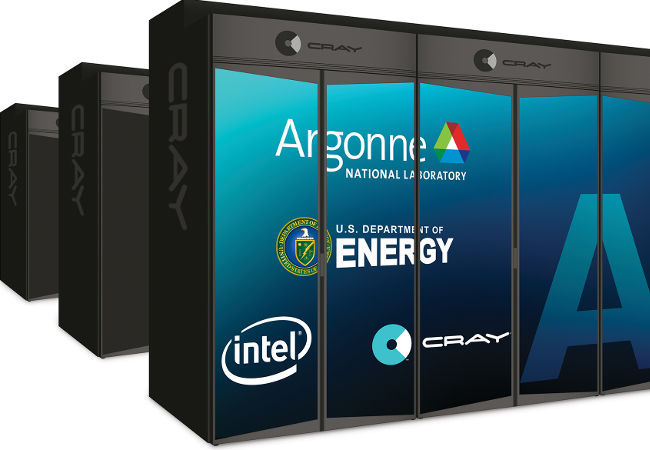Uncle Sam To Put Aurora Supercomputer To Work On Catalyst Conundrums

The US Department of Energy's Argonne National Laboratory has finally completed the installation of the Aurora supercomputer after a bevy of delays but scientists are already clamoring to put it to work.
Boffins have been waiting on the system for years. Literally. The system was originally supposed to come online in 2021 but has faced repeated delays due to Intel's challenges bringing its Xeon Phi Sapphire Rapids CPUs to market.
The final compute blades – there are 10,624 of them – were installed just last month, kicking off the Aurora Early Science Program, which prepares code that can take full advantage of the new architecture. It's also the first to use Intel's in-house Ponte Vecchio GPUs, as opposed to those from Nvidia or AMD.
One of the first projects to run on the system revolves around research and discovery of chemical catalysts, which scientists say can be used to promote the production of cleaner fuels.
Catalysts are commonly employed in chemistry to facilitate reactions. The catalytic converter on your car is a prime example, converting harmful byproducts of combustion, like nitrogen dioxide, into less worrisome substances.
"One of the main bottlenecks in catalysis development is the wide range of catalysts and operating conditions. It's extremely tedious to identify promising catalytic processes using experiments alone," DoE researcher Judit Zádor explained in a recent blog post.
Researchers plan to simulate these reactions using the supercomputer to identify new catalysts, understand how they work, and how they might be applied.
However, just as important, the research will provide insights into how workloads can be optimized. "Our main goal is to develop exascale-ready software," DoE chemist David Bross explained.
The project is just one of 15 that will gain pre-production access to Aurora under the Early Science Program, ahead of entering full production use.
- NASA to store pair of probes it's built but can't send to target asteroids
- Fancy tinkering with the atmosphere? The Derecho supercomputer can advise
- China striving to be first source of artificial general intelligence, says think tank
- It's time to mark six decades of computer networking
Simulated cicadas
While scientists put Aurora through its paces, researchers at Stony Brook University are using the Summit supercomputer at Oak Ridge National Laboratory (ORNL) to explore another peculiar phenomenon: cicada wings.
As strange as it sounds and for reasons that are still not fully understood to science, the insects have wings that can apparently kill microbes on contact.
The implications being that if you can replicate this behavior, scientists could develop new antibacterial materials. Unfortunately, while research shows that this has something to do with the naturally occurring microstructures found on the insect's wings, and have even been able to recreate the effect, what exactly makes them so deadly to microbial life has proven illusive.
"At this moment, we know that the cicada wing can prevent bacteria adhesion, but the mechanism is not clear," Tadanori Koga, an associate professor at Stony Brook, explained in an ORNL blog post.
And that's where ORNL's Summit supercomputer comes into play. While the system can't hold a candle to Argonne's Aurora or even ORNL's 1.1 exaFLOPS Frontier, it's by no means a slouch as the world's fifth most powerful supercomputer as of June's Top500 ranking.
In collaboration with ORNL's Jan-Michael Carrillo, who works in the lab's Nanophase Material Sciences Center, the team has conducted a series of molecular dynamics simulations, involving roughly a million digital particles, to glean insights into the nature of the cicada's disinfectant qualities.
They revealed that the micropillars found on cicada wings attract the bacteria, putting the membrane under enough tension that it ruptures, killing the cell in the process.
"So, we wanted to control the size and the height of the pillar and the spacing between the pillars," said Koga. "And then we wanted to see what is crucial to killing bacteria. That's the whole idea of this project."
What's more, scientists determined that this process was naturally self-cleaning, which means that remnants of the cell didn't remain attached to the surface. This is good news because any crud left behind can provide microbes a foothold to spread.
"This was thought to be due to the insect moving its wings to shake off the debris. But with our methodology and structures, we prove that they just naturally kill and clean themselves," Maya Endoh, a research professor at Stony Brook, explained. ®
From Chip War To Cloud War: The Next Frontier In Global Tech Competition
The global chip war, characterized by intense competition among nations and corporations for supremacy in semiconductor ... Read more
The High Stakes Of Tech Regulation: Security Risks And Market Dynamics
The influence of tech giants in the global economy continues to grow, raising crucial questions about how to balance sec... Read more
The Tyranny Of Instagram Interiors: Why It's Time To Break Free From Algorithm-Driven Aesthetics
Instagram has become a dominant force in shaping interior design trends, offering a seemingly endless stream of inspirat... Read more
The Data Crunch In AI: Strategies For Sustainability
Exploring solutions to the imminent exhaustion of internet data for AI training.As the artificial intelligence (AI) indu... Read more
Google Abandons Four-Year Effort To Remove Cookies From Chrome Browser
After four years of dedicated effort, Google has decided to abandon its plan to remove third-party cookies from its Chro... Read more
LinkedIn Embraces AI And Gamification To Drive User Engagement And Revenue
In an effort to tackle slowing revenue growth and enhance user engagement, LinkedIn is turning to artificial intelligenc... Read more

